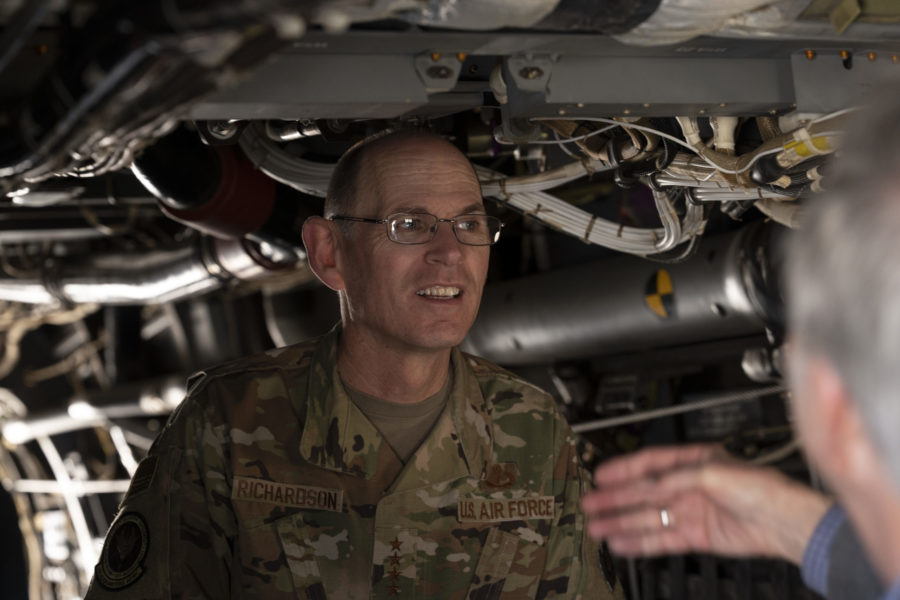The head of Air Force Materiel Command is telling supervisors and commanders to “revisit” the current use of telework on their teams, emphasizing the importance of “face-to-face team interaction.”
Gen. Duke Z. Richardson sent the update to AFMC personnel Nov. 30 to explain his “commander’s intent” for telework within the major command, an AFMC spokesperson confirmed to Air & Space Forces Magazine.
The update didn’t change any policy regarding telework. Amid the COVID-19 pandemic in May 2021, the Air Force released updated guidance on its policies and expanded opportunities, allowing squadron commanders or their equivalents to determine whether positions were eligible for telework, with input from supervisors.
But while the pandemic led the Air Force to dramatically expand its use of telework arrangements, Richardson said in his update that the “timing is right for supervisors to revisit the telework posture and determine the optimal blend for individuals, teams, centers, and the headquarters,” according to AFMC spokesperson Derek Kaufman.
“While maximizing telework at the height of pandemic infections absolutely made sense, the current situation is different,” Kaufman added, summarizing Richardson’s update. “Supporting our joint warfighters, accelerating change and delivering integrated capabilities faster than China, demands long-term and focused effort. [Richardson] articulated a belief face-to-face team interaction yields faster and better solutions.”
Going along with that belief, Richardson identified what Kaufman called “guiding principles” for supervisors at AFMC—that in general, staff should spend a “preponderance” of duty hours at the office, and that teleworking levels will be “higher than before the pandemic, but less than the height of the pandemic.”
Tammy Lyons, acting director of AFMC manpower, personnel, and services, clarified to Air & Space Forces Magazine that “in most cases, the AFMC commander expects personnel assigned to HQ AFMC staff positions to work more time in the office than by telework,” while specific schedules are determined by supervisors based on requirements, eligibility, and mission needs.
“In evaluating telework, compressed work schedules, and similar flexibilities, supervisors are responsible for achieving the mission, while being responsive to unique individual and team circumstances,” Kaufman added.
While the general expectation is for service members and civilians to spend the majority of their time in the office, there isn’t an exact ratio for the entire MAJCOM to pursue—Richardson is not “mandating percentage goals for telework,” Lyons said.
Still, Richardson’s approach does seem to represent a shift from previous views voiced by Air Force leaders who suggested the service would embrace telework writ large even after the pandemic.
In September 2020, then-Vice Chief of Staff Gen. Stephen W. “Seve” Wilson suggested that as many as 30 percent of Air Force employees would permanently telework.
In the same timeframe, then-Deputy Chief of Staff for Manpower, Personnel, and Services Lt. Gen. Brian T. Kelly said telework could allow the Air Force to change its approach to temporary duty travel and permanent changes of station, letting service members have more stability by living in one location while teleworking to new assignments.
Around the same time, the Defense Innovation Board, responsible for advising the Pentagon on how it can become more innovative and technology-friendly, released a report urging the DOD to embrace remote work and telework by expanding and upgrading its IT networks, offering more opportunities for secure classified work, starting remote work pilot programs, and more.
A year later, in September 2021, then-commander of AFMC Gen. Arnold W. Bunch Jr. told Airmen that “we will not go back to what we were doing before” the pandemic with regard to telework. Specifically, Bunch set a goal of 50 percent of AFMC headquarters staff teleworking either permanently or partially.
By embracing telework during the pandemic, Bunch said at the time, “we have demonstrated that we can execute the mission.”
The balance of in-office work and telework has been a delicate one for employers and employees not just in the military but across the workforce.
Some jobs, particularly in the military, simply cannot be done virtually—for the Air Force, flight line operations, classified programs, and more require in-person work.
But among those who can do their work remotely, a July survey from Gallup of the general public found that 34 percent preferred to telework exclusively, while 60 percent preferred a hybrid of remote and in-office. The survey also found that “the demand for long-term remote flexibility has substantially increased,” with roughly 60 percent of permanent teleworkers saying they would switch jobs if not offered flexibility, and 30 percent of hybrid workers saying the same.
Increasingly, more and more employees are headed back to the office in some form or fashion, though not at the levels seen before the pandemic.
